Send us your Eris of the Month Club submissions (more info here) by using the form at the bottom of The MGT. page.
Hail Eris! All Hail Discordia!
Send us your Eris of the Month Club submissions (more info here) by using the form at the bottom of The MGT. page.
Hail Eris! All Hail Discordia!

One of Discordianism’s two founders, Kerry Thornley, famously declared that if ‘religion is the opium of the masses, [then] Discordianism is the marijuana of the lunatic fringe,’ and this is made nowhere more clear than in its material culture over the last fifty-six years.2 The majority of Discordianism’s material culture has been comprised of self-published work in the form of religious certificates, ‘zines’, APAs (amateur press associations), live audio recordings of Robert Anton Wilson lectures, and, with the advent of the internet, BBSes (Bulletin Board System), PFDs, and blogs.3 The paper ephemera of Discordianism’s material history has not been catalogued by libraries, nor preserved by universities, but commonly remains in the possession of its initial recipients, or forgotten in the boxes that compose private zine archives. Lacking any familiarity with this ‘underground’ material, scholarly analysis of the mass-marketed Discordian texts, and Discordianism in toto, has been altogether superficial.
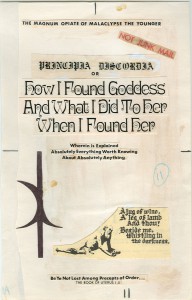
The second issue concerns the lack of scholarly convention concerning which version of the Principia is regarded as authoritative. As a result of the 4th edition Principia’s ‘copyleft,’ or anti-copyright status, there are no less than five different published versions of the 4th/5th edition, in addition to innumerable online versions. While there is not a great deal of difference between versions, scholarly neglect of this point, as well as the lack of convention concerning which version of the 4th/5th edition of the Principia should be treated as authoritative, has instilled an unnecessary amount of irregularity into the study of Discordianism.6
The third issue is partly based on the first, but regards a more general misinterpretation of the meaning of the Principia within the Discordian milieu. Scholars regard the 4th/5th edition of the text as the central Discordian holy work, and it is not hard to understand why; it seems to offer all of the requisite data for a normative appraisal of a religious movement. It contains an origin story for the religion, a list of commandments, a liturgical calendar, a list of saints, and an account of Discordianism’s principle deity, Eris. In sum, the 4th/5th edition of the Principia seems to be a perfect index of everything a ‘real’ religion needs. This, of course, is precisely the problem. Leaving aside the fact that many of the aforementioned ‘religious’ aspects of Discordianism were added in successive editions of the Principia, the primary issue here is that Discordianism is explicitly not based on liturgical observance or orthopraxis, but rather on the utilization of beliefs as heuristic tools. Scholarly preoccupation with the religious minutia contained in the Principia evidences that scholars have missed an essential aspect of the Discordian ludibrium.
Since the various publications of the 4th and 4th/5th editions of the Principia read like conventional holy texts, or at least as a parody of one, scholars have mistakenly taken it as the text that has governed Discordianism since its inception. While some contemporary Discordians may revere it as such, familiarity with previous editions of the text, let alone the history of Discordianism, make it clear that this was not always the case. Discordianism did not reach underground audiences until nearly two decades after it was founded, and even then it was not an edition of the Principia that publicized the religion, but a trilogy of novels. Despite having numerous quotes from the Principia, the fictitious nature of Robert Anton Wilson and Robert Shea’s Illuminatus! trilogy (1975) of novels led many to believe that the Principia did not actually exist á la Lovecraft’s Necronomicon. Needless to say, Discordianism’s underground popularization was not based on teachings outlined in the first, second, third, or fourth editions of the Principia, but Wilson and Shea’s interpretation of them in Illuminatus! The first widely popular edition of the Principia was published nearly five years after Illuminatus! as a result of Loompanics publisher Mike Hoy reading the trilogy, and querying Hill himself as to the existence of such a text.7 The shift to institutionalization in contemporary Discordianism has led to the formalization of Discordian beliefs, and, central to this has been the reframing of the Principia as foundational to the religion. The scholarly preoccupation with the contents of the Principia illustrates the way in which scholars’ research agendas owe more to the contemporary trend towards institutionalization within the religion than rigorous historical research on it.
Read in terms of its evolution and alongside other Discordian material, it is evident that the various editions of the Principia were never merely parodies of sacred texts, nor were they strictly genuine attempts to fashion one. Instead, they were iterations of an idiosyncratic form of genre appropriation based on the conviction that all beliefs are heuristic tools for creating models of reality. Said more precisely, the various editions of the Principia were not just satire, but prime examples of the assiduous playing with religious forms that epitomizes Discordian belief. Essentially, this type of humorous play functions as the liturgical language of Discordianism. Reflecting William Burroughs’s famous adage, ‘nothing is true and everything is permitted,’ Discordianism is a meta-belief system in which abstract concepts like ‘holy scripture’ are utilized as expedient means to destabilize fixed assumptions about reality. Though more salient in later editions, the Principia appropriated the genre of sacred scripture in the same way that Camden Benares’ Discordian treatise, Zen Without Zen Masters (1977), utilizes tropes associated with Zen koan books, and the same is true for the appropriation of conspiracy theory in Wilson and Shea’s Illuminatus! trilogy. Discordian texts have taken the form of science fiction epics, historical dramas, anarchist philosophy, psychologized-occult manuals, and Zen teachings, and regardless of their form, the dynamics of these genre appropriations are the same. Discordian authors appropriate genre conventions only to exploit their ability to communicate the central metaphysical truth of their religion, namely, that the experience of reality entirely depends on the belief system, or model through which it is comprehended.8
Christian Greer is a PhD researcher in the field of Western esotericism at the University of Amsterdam. His primary focus is the history and material culture of Discordianism, the Church of the SubGenius and the Moorish Orthodox Church, particularly in the 1980-1990s. His dissertation, Angelheaded Hipsters: From Beatnik Antinomianism to Psychedelic Millenarianism is an intellectual history of the “counterculture” beginning with the revolutionary movements of the 1960s and ending in the 1990s with cyberpunk and fin de siècle cyberculture.
https://uva.academia.edu/ChristianGreer
1 For a more detailed analysis of this problem in the work of one scholar, see Greer, Christian. ‘Review of Carole M. Cusack’s Invented Religions: Imagination, Fiction and Faith,’ Correspondences 2.1 (2014), pp. 109–114.
2 Thornley, Kerry. ‘Introduction’ in Principia Discordia 4th/5th edition, Lilburn, GA; Illuminet Press, 1991, p.i.
3 See Greer, ‘Occult Origins’, pp. 166-187.
4 The Loompanics edition (1979) is known as the ‘4th/5th edition’ because it reprinted the original 4th edition published by Rip Off Press in 1970, as well as the 5th edition, which was nothing more than a Western Union telegram filled with the letter ‘M’. The Loompanics version is most likely considered authoritative on account of it being the first to include the 5th edition telegram, as well as material that was not included in previous editions, e.g. ‘the Gypsie Skrypto interview,’ and an introduction by Robert Anton Wilson. For a more comprehensive overview of the publishing history of the Principia Discordia see Gorightly, Adam. ‘Adam Gorightly on the Publishing History of the Principia Discordia’ https://www.youtube.com/watch?v=bUqVrH4luXc accessed 04/05/13; see also f.8.
5 Cusack’s Invented Religion (2010) exemplifies this error insofar as her familiarity with the Principia Discordia is limited to two mass marketed 4th/5th editions of the text, which bear little resemblance to the first edition produced decades earlier. This is made obvious by the fact that she seems unaware that the first edition had a different title as well as entirely different contents. See Cusack, Carole. Invented Religions: Imagination, Fiction and Faith, Farnham: Ashgate, 2010, p.28-29 as compared to the first edition reproduced in Gorightly, Adam. Historia Discordia: The Origins of the Discordian Society. New York: RVP Press, 2014, pp.25-80. Cusack is by no means the only scholar to make this mistake, indeed, the difference between editions of the Principia has not been noticed within any notable study of Discordianism; see also Urban, Hugh. Magia Sexualis: Sex, Magic, Liberation in Modern Western Esotericism. Berkeley: University of California Press, 2006, p. 233-235; Versluis, Arthur. American Gurus: From Transcendentalism to New Age Religion. New York: Oxford University Press, 2014, p.123-138.
6 The three most important academic texts on Discordianism have all used different versions of the 4th/5th edition of the Principia: Cusack cites the Steve Jackson Games version in Invented Religion (2010), Urban references the Loompanics version in Magia Sexualis (2006), and Versluis based his work in American Gurus (2014) on the Illuminet edition.
7 The earliest version of the popular Loompanics edition of the Principia was published in 1979, and it featured an introduction by Hoy. This version was superseded by the popular 1980 edition, which contained Wilson’s introduction. See Gorightly, ‘Adam Gorightly on the Publishing History of the Principia Discordia’.
8 Wilson refers to the means by which an individual can ‘meta-program’ their own reality as the ‘final secret of the Illuminati’. See Wilson, Robert A. Cosmic Trigger: Final Secret of the Illuminati Vol.1, Tempe, AZ.: New Falcon Publications, 1997, pp.29, 68-71.
“If they prove
that you are CIA,
demand back pay.”
—Letter from Discordian Society
co-founder Greg Hill to Kerry Thornley
dated February 19th, 1968
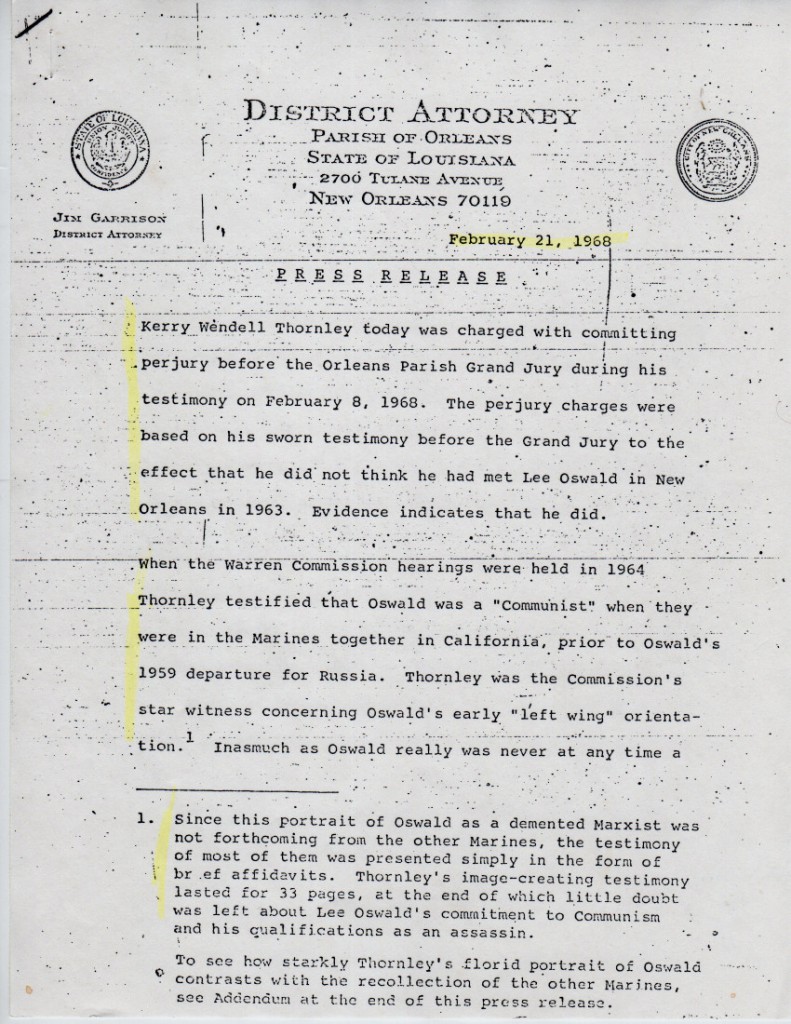
During the course of research for The Prankster and the Conspiracy: The Story of Kerry Thornley and How He Met Oswald and Inspired the Counterculture (Amazon), I was unable to pin down any tangible evidence supporting these Thornley-CIA allegations and eventually just wrote them off as more of Garrison’s unsupported theories. Thus it came as a bit of a surprise to me when—in 2006—I happened upon Joan Mellen’s Farewell To Justice (Amazon) which stated in its preface:
“Kerry Thornley, the Marine Corps buddy of Lee Harvey Oswald, who told the Warren Commission that Oswald was a Marxist, turned out himself to have been a CIA employee trained, according to a CIA document, in Washington D.C., in chemical and biological warfare…”
At the time, this claim that Thornley was a documented CIA spook came as quite the stunner, and shortly afterwards I shared Mellen’s provocative pronouncement with Thornley’s long time friend, Louise Lacey, whose initial response was a sudden burst of laughter, followed by: “Dear, if Kerry was CIA, I think I would have known.”
“Dear, if Kerry was CIA,
I think I would have known.”
—Louise Lacey
Louise, it should be noted, edited Thornley’s book Oswald for New Classics House back in 1965 and then later worked for Ramparts magazine as research director during Ramparts in-depth investigation of the JFK assassination, the first national magazine that was openly critical of the Warren Report. To this end, Louise worked alongside such notables as David Welsh, Mae Brussell, David Lifton and William Turner, and so when speaking of Thornley and/or the JFK assassination, Louise not only comes to the subject as someone who was a close friend of Thornley’s, but also someone involved very early on in JFK assassination research.
In Spring 2011, while conducting research for Caught in the Crossfire: Kerry Thornley, Lee Oswald and the Garrison Investigation (Amazon), I contacted Joan Mellen on how to go about obtaining a copy of this “CIA document” related to Kerry Thornley. Mellen replied that she’d send me a copy after she had time to recover from a recent medical ailment. Afterwards, I contacted Mellen periodically—on probably a half dozen occasions—but never heard back from her. Mellen, it should be noted, is still standing by her claim that Thornley was a CIA agent as evidenced in this recent interview.
More recently—on the advice of researcher Stu Wexler—I conducted a search of John Armstrong’s JFK assassination files at Baylor University online, where, lo and behold, I came across a copy of the document in question, which I post here for review.
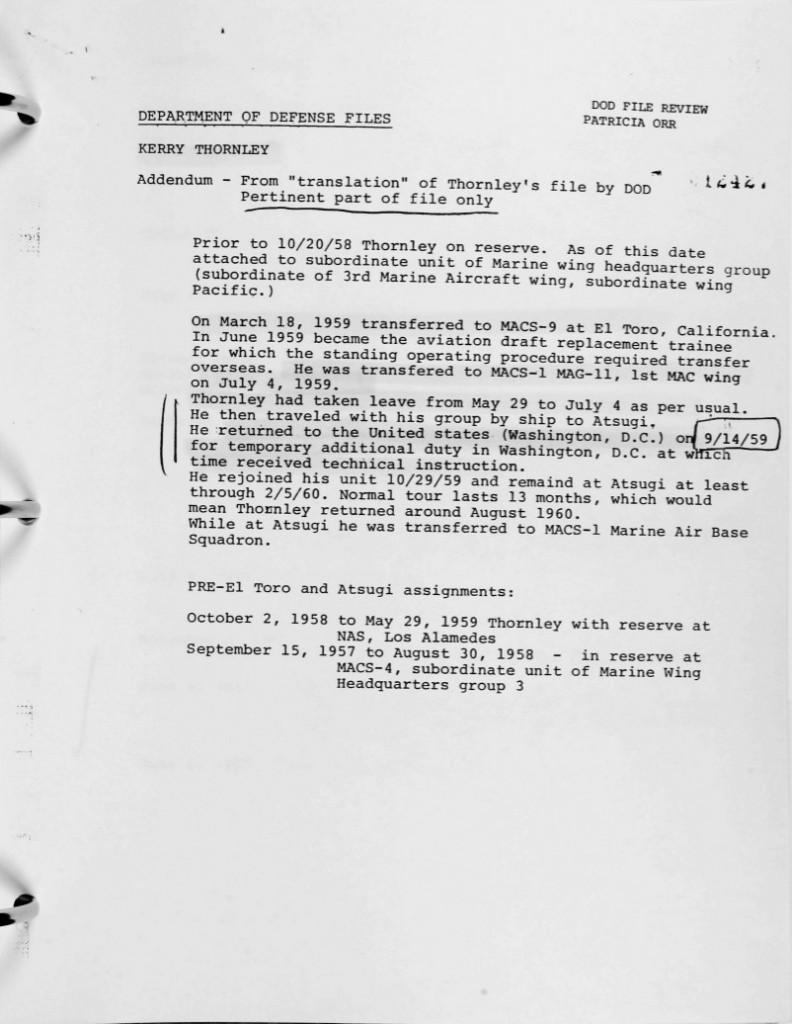
In Farewell to Justice, Mellen identified the above as a CIA document and, alternately, as a DOD document. Page one clearly identifies it as a DOD document “translation” which was created as a request to the DOD from the House Select Committee on Assassinations (HSCA) in 1978. The upper right hand corner of the document is stamped:
Patricia Orr was a researcher for the HSCA and it appears that the document is her translation of Thornley’s service record. The document confirms that Thornley received training in biological and chemical warfare, but how Mellen arrived at the conclusion that this training was conducted by the CIA is unclear. In fact, there’s no mention of the CIA anywhere in the document—unless one is reading deeply between the lines. Well, there are the three last letters of Orr’s first name to consider perhaps.
It should be noted that Thornley received this biological and chemical warfare training at Atsugi Base in Japan which served as a CIA outpost during this period. In this regard, it’s conceivable that Thornley—and other Marines stationed at Atsugi—could have received training from CIA personnel also stationed at the base, but Mellen’s assertion that Thornley was a CIA employee is unsupported by the DOD document. What the thinker thinks, the prover proves…
On page 276 of Farewell To Justice, Mellen writes:
“From the Department of Defense files comes a document placing Thornley as a CIA employee who attended Chemical and Biological Warfare School. Receiving ‘technical instruction’ in Washington, D.C., Thornley moved from ‘confidential’ to ‘secret’ clearance. His course in ‘Atomic, Biological and Chemical Warfare’ ran from June to August 1960, and had begun at Atsugi…”
The term Mellen uses—“technical instruction”—actually appears in Thornley’s service records as “Tech instruct” which was an abbreviation for “Technique of Instruction,” a Marine Corps competition Thornley entered during this period.
According to the author’s page of Oswald, Thornley “…served in the Far East, in the First Marine Aircraft Wing, and distinguished himself again as a public speaker on political/philosophical issues by winning first place in the Wing Technique of Instruction Competition. He was therefore sent to Washington to appear in the finals…”
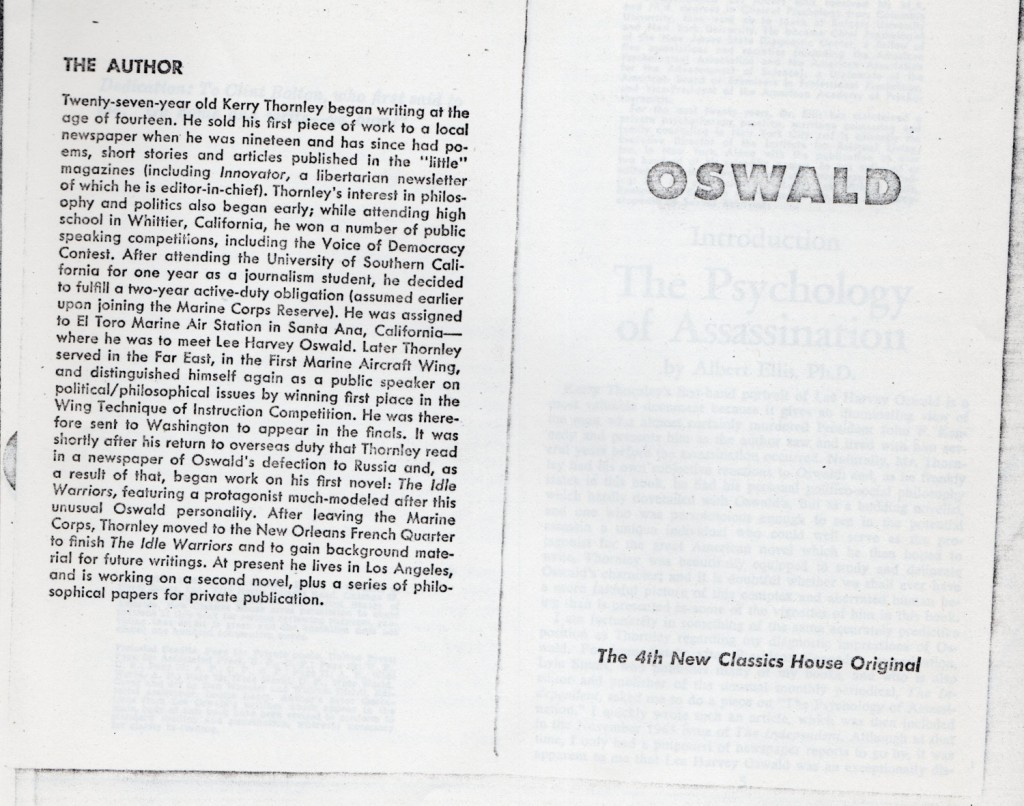
The August 1959 edition of Leatherneck magazine also mentions that the Technique of Instruction competition was scheduled to be held in September 1959 in Washington, DC., which is listed in an entry from page 3 of Thornley’s DOD file:
| 14 Sep 59 Tech instr |
to TAD | Wash, DC |
While Joan Mellen found Thornley’s visit to Washington, D.C. somehow suspect, his service record—and other supporting documents which I post here—suggest that he was simply attending a Marine Corps public speaking competition, which was certainly nothing unusual for Thornley. According to the author’s bio page in Oswald: “While attending high school in Whittier, California, [Thornley] had won a number of public speaking competitions, including the Voice of Democracy Contest.”
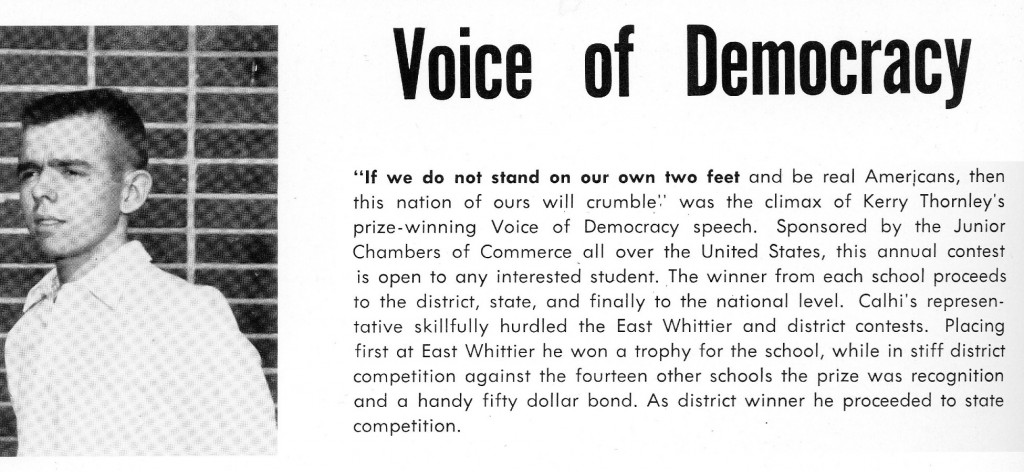
According to Joan Mellen, after Thornley received his “technical instruction” in Washington, D.C., in September of ‘59, he was “…moved from ‘confidential’ to ‘secret’ clearance….” This suggested (to Mellen, at least) that Thornley had graduated from Marines Corps Corporal to Secret Agent with the CIA.
It should be noted that “secret” clearance in and of itself is not special or unique and just because Thornley received “secret” clearance doesn’t mean he was a “CIA employee.” As my friend and former Air Force Office of Special Investigation (AFOSI) Special Agent, Walter Bosley, recently informed me:
“SECRET is the first level of anything close to serious, but it’s not the big prize level. It’s the first level of stuff that can get someone in big serious trouble if they mishandle it or, God forbid, sell it. There are a lot more personnel with SECRET than with TOP SECRET and beyond, of course, but it’s not insignificant.”
According to Thornley’s DOD file, he was assigned as “Avn Elec oper”, shorthand for Aviation Electronics Operator.
These duties were performed at Atsugi Base from which the U2 flights originated during this period, at the height of the Cold War. I would venture to guess that other enlisted men in Thornley’s unit who performed similar duties also held “secret” clearance.
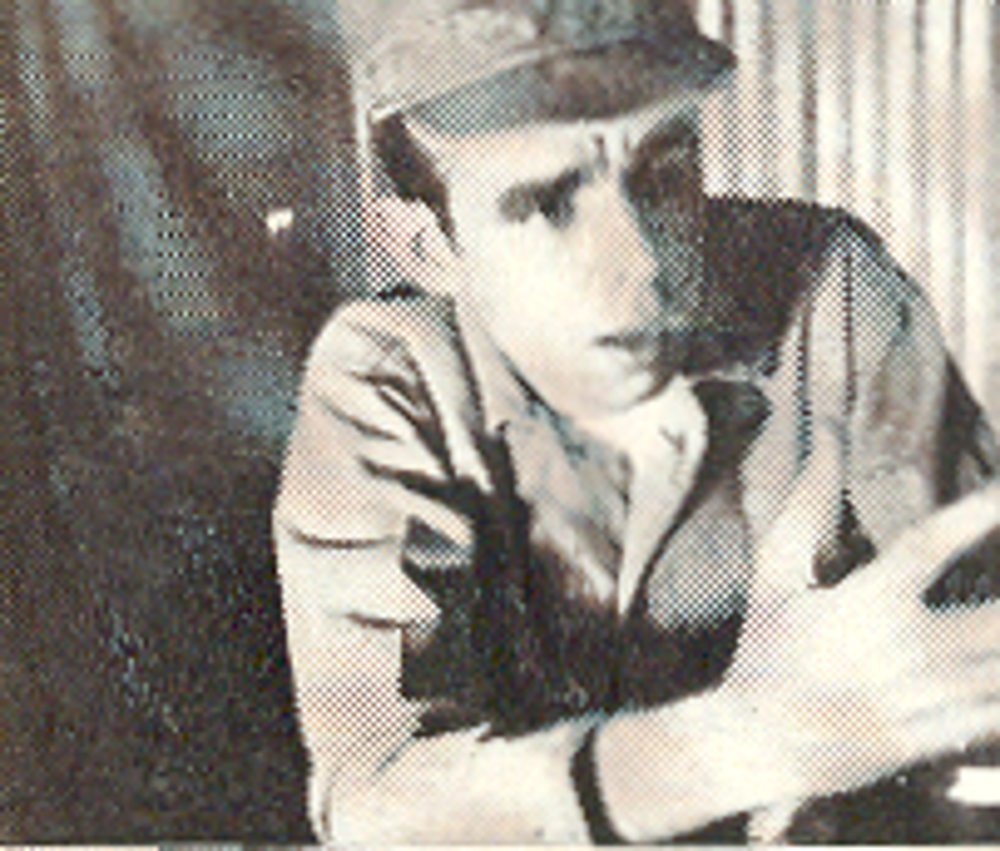
On page 67 of Farewell to Justice, Mellen endorses Garrison’s theory that the Old Post Office Building in New Orleans (also known as The Customs House) —located “across from Banister’s office”—was some sort of CIA spook central gathering place for, as Garrison described them, a “…number of young men who have been identified as CIA employees….” Garrison erroneously identified these CIA employees as Kerry Thornley, Lee Oswald, Thomas Beckham and Jack Martin, among others.
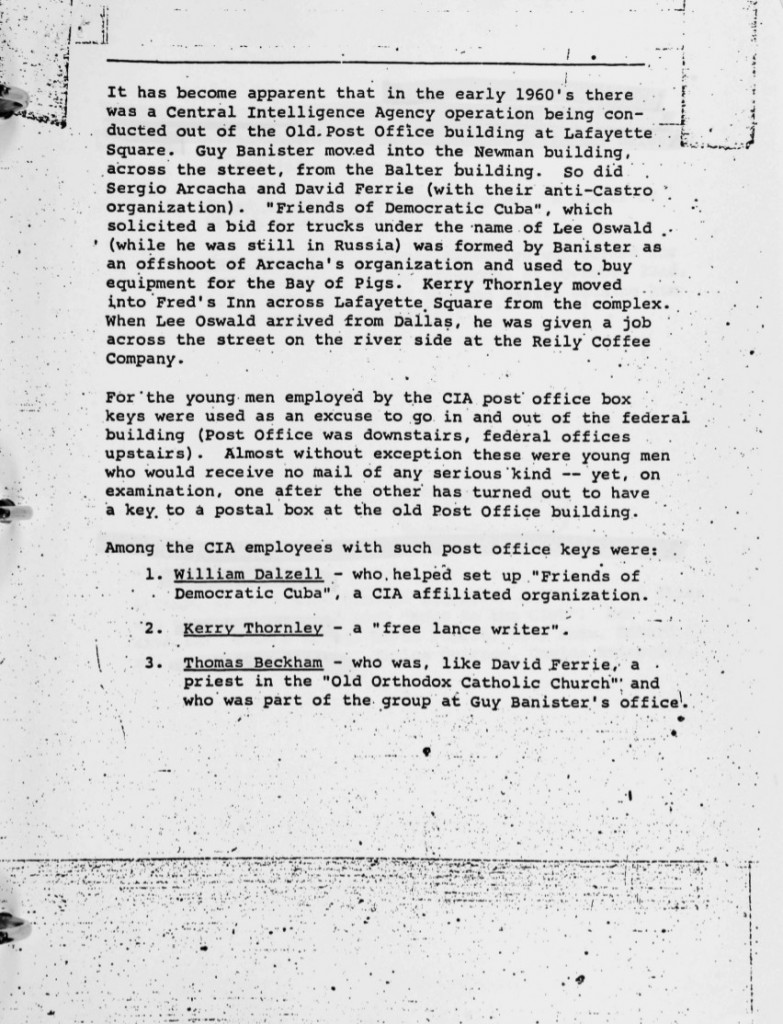
As it turns out, the Old Post Office Building was not exactly “across from Banister’s office” as Garrison described, but in reality a half mile away—or as Mellen more accurately notes in Farewell to Justice—in “close proximity.”
While Oswald was most likely involved in intelligence work during his Marine Corps service and afterwards, the claim that he was a CIA employee has never been conclusively demonstrated. To further suggest that Jack Martin or Thomas Beckham were CIA employees seems based primarily on the many sensational claims made by Beckham and Martin themselves in which I place little, if any, stock. This is not to say that I completely rule out any or all of these theories suggesting that Beckham or Martin might have been CIA agents or connected in some way to the Agency. However, these allegations are just that: theories to which Garrison never produced any substantial supporting evidence.
Lastly—to toss more water on this smoldering fire—I recently stumbled upon the following declassified CIA document (at the National Archives online database) dated January 1968.
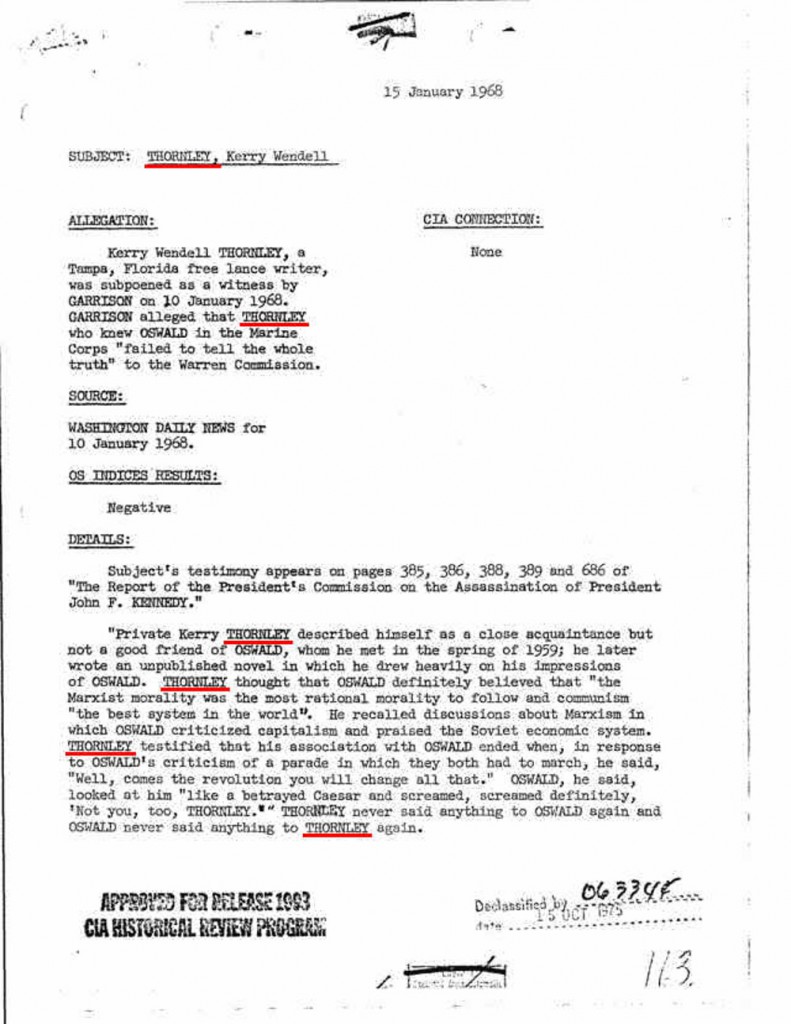
Given the 1968 date, one can assume that this document was prepared in response to Garrison’s allegation that Kerry Thornley was a CIA agent. In this regard, the document lists Thornley’s CIA connections as “None.”
But, of course, THEY would deny it!